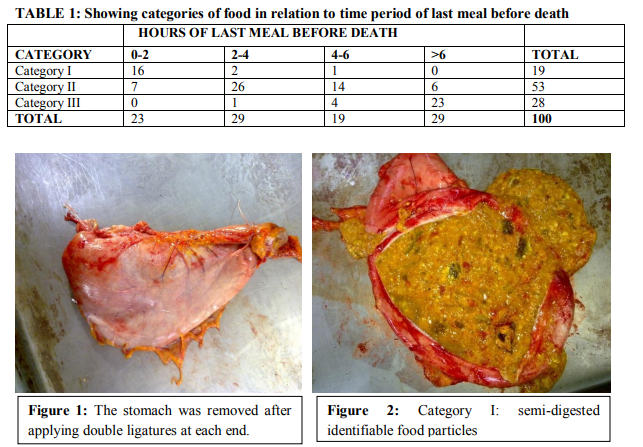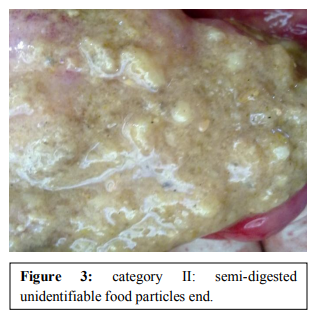IJCRR - 5(11), June, 2013
Pages: 132-136
Date of Publication: 18-Jun-2013
Print Article
Download XML Download PDF
ESTIMATION OF TIME SINCE DEATH BY GASTRIC CONTENTS
Author: Viras Patel, Dharmesh Silajiya, Kalpesh Shah, Anand Menat, Mehul Tandel, Sandip Raloti
Category: Healthcare
Abstract:The time of death estimation plays important role in solving both criminal and civil cases. The inspection of the gastric contents must be part of every postmortem examination because if the time of taking last meal is known, the approximate time of death can be made out indirectly. The rate of gastric emptying varies in man from 2.5 to 6 hours. The length of time required to empty the stomach is variable as it depends upon a host of factors like nature and consistency of food, motility of stomach, contents, environment, emotional/psychological factors and residual variations. The aim of this study is to determine approximate time of death by examination of gastric contents in deceased body brought to mortuary at Civil Hospital Ahmedabad, Gujarat. Present study was conducted on total 100 deceased persons (70 males and 30 females) whose time of death and time of last meal were known. Gastric contents were examined and divided in three categories; semi-digested identifiable food particles, semi-digested un-identifiable food particles, empty stomach. These findings were compared with time interval between last meal and time of death. In present study the identifiable semi-digested food particle were found more commonly in those persons who died 0-2 hours after last meal, un-identifiable semi-digested food particle were found more commonly in those persons who died 2-6 hours after last meal and empty stomach were found more commonly in those persons who died more than 6 hours after last meal. From present study we conclude that indirect estimation of time since death can be possible from examination of gastric content but due to variability of gastric emptying in different individuals we can't exactly define time since death.
Keywords: Gastric contents, Gastric emptying, Identifiable food particles, Un-identifiable food particles, Indirect estimation of time since death.
Full Text:
INTRODUCTION
It is very important from medico-legal point of view that a medical jurist should always be prepared to give an opinion as to the time which elapsed since death, when a body is brought to him for post-mortem examination1 and it is also plays important role in solving both criminal and civil cases2 . The point to be noted in ascertaining the time are warmth or cooling of the body, the absence or presence of cadaveric hypostasis, rigor mortis and the progress of decomposition. All these point discussed at full length in every Forensic Textbook, but it must be remembered that the conditions producing these changes vary so much in each individual case, that only very approximate time of death can be given. In addition to these, the time of death can be ascertained to some extent from the contents of stomach bladder and the intestines.1 The original hypothesis was founded on belief that food spent a fairly uniform time in a stomach before being released into the duodenum.3 The rate of gastric emptying varies in man from 2.5 to 6 hours.1 If the time of taking last meal (quantity as well as quality) is known, the approximate time of death can be made-out indirectly. The length of time required to empty the stomach is variable as it depends upon a host of factor like nature and consistency of food, motility of stomach, contents, environment, emotional /psychological factors and residual variations.4
AIM OF STUDY
To determine approximate time of death by naked eye examination of gastric contents of the deceased body.
MATERIAL AND METHODS
Present study was conducted on total 100 deceased persons (70 males and 30 females) brought to mortuary at Civil Hospital Ahmedabad, Gujarat. The present study includes the cases whose time of death and time of last meal were known. The included subjects were mostly the cases of sudden death (Accidental spot death, Myocardial infarction, etc.) and; the other cases whose time of death and time of last meal were not known excluded from this study. For examine the gastric contents; the stomach was removed after applying double ligatures at each end, and was placed in clean dish. It was opened along its greater curvature, from cardiac to pyloric end, then gastric contents examined.5 After examined, contains divided in three categories; category I: semi-digested identifiable food particles, category II: semi-digested unidentifiable food particles and category III: empty stomach. These findings were compared with time interval between last meal and time of death.
RESULTS
Amongst 100 deceased bodies studied, Category I gastric contents (semi-digested identifiable food particles) was found in 19 cases out of which 16 cases had taken their last meal about 0 to 2 hours before death, 2 cases had taken 2 to 4 hours before, 1 case had taken 4 to 6 hours before and no one had taken last meal more than 6 hours before death. Category II gastric contents (semi-digested unidentifiable food particles) was found in 53 cases out of which 7 cases had taken their last meal about 0 to 2 hours before death, 26 cases had taken 2 to 4 hours before, 14 case had taken 4 to 6 hours before and 6 cases had taken last meal more than 6 hours before death. Category III gastric contents (empty stomach) was found in 28 cases out of which 0 cases had taken their last meal about 0 to 2 hours before death, 1 cases had taken 2 to 4 hours before, 4 case had taken 4 to 6 hours before and 29 cases had taken last meal more than 6 hours before death.
DISCUSSION
The examination of gastric contents is an essential component of a forensic autopsy and discovery of pathology, or evidence, of the ingestion of drugs and poisons is of obvious significance. The identification of the last meal is also of recognized value, but the use of this observation to estimate the time interval between the eating of the last meal and death is a more controversial area, particularly when it is used to calculate the time of death from the time of a known last meal.6 The medical examiner can often use the contents of the victim’s stomach to help determine time of death.7 However, the rate of emptying of stomach varies in healthy persons. The emptying of stomach depends on the: consistency of food, motility of the stomach, osmotic pressure of the stomach contents, quantity of food in the duodenum, surroundings in which food is taken, emotional factors and residual variations.1
A carbohydrate meal leaves the stomach more rapidly than a protein meal, because carbohydrates are reduced to a semi-fluids state rapidly and a protein meal leaves the stomach more rapidly than fatty meal. Fluids and semi-fluids leave the stomach very rapidly (within 2 hours), after being swallowed. If water is ingested with solid meal, the water is emptied rapidly and separately and is not influenced by either the weight/total calories of the accompanying solid meal. Milk leaves rapidly, whereas meat and pulses are retained longer.8 ‘dals’ usually retain their form up to 2 hours and ‘rice’ grains up to3 hours.4 According to Pekka Saukko and Bernard Knight3 (2004) the physiological process of digestion of an ‘average’ meal lasted some 2 to 3 hours, Modi1 (2011) gives 2.5 to 6 hours in man. Adelson9 (1974) stated that stomach begins to empty within 10 minutes of swallowing, that a light meal leaves the stomach by two hours, heavy meal takes 4-6 hours. All these values, however, are subject to considerable variation. Stomach contains which are identifiable by naked eye are usually ingested within two hours period.8 If a victim’s stomach contains largely undigested food material, then the death likely occurred within an hour or two of the meal. If the stomach is empty, the death likely occurred more than four hours after eating.7 In present study among gastric contents of 100 deceased persons (70 males and 30 females) examined: semi-digested identifiable food particles were found more commonly in those persons who died 0-2 hours after last meal, semi-digested un-identifiable food particles were found more commonly in those who died 2-6 hours after last meal and empty stomach were found more commonly in those who died more than 6 hours after last meal.
CONCLUSION
If the medical examiner can find out through witness statements when the last meal was consumed, he can use this to determine the time of death. If a man is found dead in a hotel room and the medical examiner determines that his stomach is full of undigested identifiable food materials. If he had dinner with a business associate from 9 to 10 pm, then returned to his room, the finding of gastric contents would indicate that the death occurred shortly after he returned to his room. The medical examiner might place the time of death between 10 pm and midnight. These calculations depend on a number of factors. Heavy meals and those rich in protein and fat digest more slowly than do small meals and those high in carbohydrates, sugars and liquids. The consumption of alcohol or many sedative and narcotic drugs, as well as some medical conditions, tend to slow digestion and gastric emptying, while other drugs and medical conditions hasten these processes. Also, there is great individual variation in rate of digestion. Therefore, gastric contents are of marginal help in time of death determination. To elaborate this study, individual can do this study on the new way with the help of exact time of death, exact quantity and quality of last food, intestinal contents, history of man who died, etc. So from this study we can calculate approximate time of death indirectly by examine gastric content but due to various factors affecting gastric emptying in different individuals we can’t define exact time of death. This may use as support to other procedure to estimate time since death.
ACKNOWLEDGEMENT
Authors acknowledge the great help received from the scholars whose articles cited and included in references of this manuscript. The authors are also grateful to authors / editors / publishers of all those articles, journals and books from where the literature for this article has been reviewed and discussed. Authors are grateful to IJCRR editorial board members and IJCRR team of reviewers who have helped to bring quality to this manuscript.
References:
1. Justice K Kannan, Dr K Mathiharan, Modi’s textbook of medical jurisprudence and toxicology, 24th ed, 2011: 14; 354.
2. Jatti, Vijaya Kumar B., Dharmaraya Ingale, and Chandrashekhar Karpoor. "Estimation of time since death by gastric contents: An overview." Indian Journal of Forensic Medicine andToxicology 4.2 (2010).
3. Saukko, P., and B. Knight. "The pathophysiology of death." Knight’s forensic pathology. 3rd ed. London: Edward Arnold (2004): 83.
4. Vij, Krishan. Textbook of Forensic Medicine and Toxicology: Principles and Practice, 5/e. Elsevier India, 2008: 94.
5. Reddy, K. S. "The essentials of forensic medicine and toxicology." Journal of Punjab Academy of Forensic Medicine and Toxicology 31st ed; (2012): 5; 103.
6. Horowitz, M., and D. J. Pounder. "Is the stomach a useful forensic clock." Australian and New Zealand journal of medicine 15.2 (1985): 273-276.
7. Lyle, D. P. Howdunit Forensics. Writer's Digest Books, 2008. Chapter 5.
8. Reddy, K. S. "The essentials of forensic medicine and toxicology." Journal of Punjab Academy of Forensic Medicine and Toxicology 31st ed; (2012): 7; 163.
9. Adelson, Lester. "The pathology of homicide." Springfield, IL: Charles C. Thomas (1974): 188-318.


|






 This work is licensed under a Creative Commons Attribution-NonCommercial 4.0 International License
This work is licensed under a Creative Commons Attribution-NonCommercial 4.0 International License